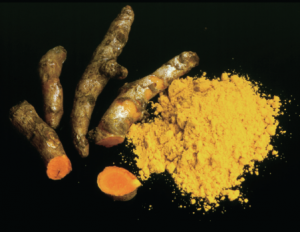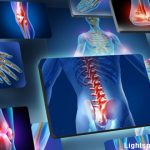
TH Foto-Werbung / Science Source
During a recent divisional grand rounds presentation, I asked a room full of my colleagues how many of them had been asked about turmeric by a patient within the past year, month, week or day. Most hands remained up by the end of the exercise.
During a recent trip to New York City, I was amused to discover that turmeric tea was sold out at a high-end ice cream shop in the East Village.
During a recent Google search, I was equally amused to learn of the many purported benefits of turmeric. Turmeric could help me “lose weight.” Turmeric could help “tame herpes outbreaks.” Turmeric could help “ease joint pain.” Turmeric could even help “prevent
cystic fibrosis.”
With so much unsubstantiated evidence available to the lay public about turmeric and so much interest in its possible health benefits, a review of the evidence was clearly in order.
Background
Turmeric is an orange-yellow powder ground from the root of the turmeric plant (Curcuma longa, Curcuma domestica or Curcuma aromatic). It is native to the Indian subcontinent and Southeast Asia, and has long been used in Ayurvedic and Chinese medicine. The active ingredient in turmeric is curcumin, which makes up about 4–6% of the spice readily available for purchase at your local grocery store.
With regard to mechanism of action, several in vitro studies have found turmeric has both anti-inflammatory and anti-oxidant properties. Turmeric can inhibit matrix metalloproteinases that degrade extracellular matrix, and decrease the synthesis of IL-6, IL-8, and prostaglandin E2. Turmeric can selectively inhibit cyclooxygenase-2, inhibit synoviocyte proliferation, and reduce reactive oxygen and nitrogen species.1
The Science
Few studies have investigated the efficacy of turmeric for arthritis, but more are underway.
One study from Thailand demonstrated the non-inferiority of turmeric toibuprofen. This was a multi-center,double-blinded, randomized controlled trial of 367 patients with knee osteoarthritis.2 Patients, most of whom were women in their 60s, were randomized to a total daily dose of 1,200 mg ibuprofen vs. 1,500 mg of Curcuma domestica for four weeks.
Both groups saw a statistically significant improvement in Western Ontario and McMaster Universities Osteoarthritis Index (WOMAC) total scores. Mean WOMAC total scores changed from a baseline 5.2 ± 1.7, to 3.23 ± 1.97 in the ibuprofen group and 3.36 ± 2.04 in the curcumin group (P<0.001). There were also significant improvements in the WOMAC pain subscale, stiffness subscale and function subscale for both groups. There was no difference in between-group changes (i.e., non-inferiority). There was no difference in total adverse events between groups, although more patients taking ibuprofen experienced abdominal pain (18.1% vs. 10.8%, P=0.046).
It is important to take note of the daily dose of ibuprofen used in this study, which is about half the dose commonly prescribed for arthritis patients in the U.S. (ibuprofen 400 mg three times daily [TID] vs. 800 mg TID); the authors attributed this choice to the smaller size of the Thai patients studied.
A 2016 systematic review and meta-analysis in the Journal of Medicinal Food included eight randomized controlled trials that examined the use of turmeric in patients with knee osteoarthritis and rheumatoid arthritis.3 The mean daily dose of curcumin was 1,000 mg, with intervention periods of eight to 12 weeks. Pain visual analogue scale scores decreased by a mean 2.04 points compared with placebo (P<0.00001). WOMAC total scores decreased by a mean 15.3 points compared with placebo (P=0.009), although the confidence interval was fairly wide (CI -26.9 to -3.77). It should be noted that a few of the studies examined combination therapy with curcumin plus diclofenac, or curcumin plus glucosamine-chondroitin supplements, which may have affected results.
Studies have demonstrated anti-inflammatory & anti-oxidative properties of turmeric. We need more data to determine if it is truly effective for joint pain, but it is generally safe & may be worth trying as an adjunctive therapy.
A 2018 systematic review and meta-analysis in the British Journal of Sports Medicine included 69 randomized controlled trials that examined the use of a variety of dietary supplements in patients with knee, hip and hand osteoarthritis.4 Only three of these trials evaluated turmeric specifically. Only 10% of studies were judged at “low risk of bias,” and 64% were funded by pharmaceutical companies. That said, turmeric had a moderate effect on short-term-pain- and physical function-based visual analogue scales, with standard mean deviations of -1.19 and -1.13, respectively. In comparison, studies of glucosamine and chondroitin—supplements widely used by many osteoarthritis patients today—showed no benefit over placebo.
Safety Profile
As studied to date, turmeric is generally safe to ingest. At extremely high doses (upward of 8,000 mg daily), patients may experience gastrointestinal upset or bleeding, especially if on concomitant anticoagulation. Doses used in arthritis have typically not exceeded 2,000 mg daily, and this dose has not caused significant adverse effects.5
Some debate exists as to the bioavailability of curcumin; ingesting curcumin as a cooked ingredient in hot food, with a fatty meal or with black pepper (piperine) may enhance absorption.
The Bottom Line
So what do I tell my patients when they ask? I tell them studies have demonstrated anti-inflammatory and anti-oxidative properties of turmeric. We need more data to determine if it is truly effective for joint pain, but it is generally safe and may be worth trying as an adjunctive therapy.
I recommend a total daily dose of 1,000 to 2,000 mg of curcumin, which is equivalent to about five to 10 teaspoons of turmeric spice. I encourage patients to read package labels if they are purchasing curcumin supplements to confirm that no extraneous ingredients have been added.
When possible, they should look for a seal from U.S. Pharmacopeia (USP), NSF International, ConsumerLab.com or UL. For a fee paid by the supplement manufacturing company, these organizations work to certify that supplements contain the amount of product advertised and are not contaminated with toxic substances (e.g., arsenic, lead).
Moving forward, larger clinical trials are needed to determine if turmeric is truly effective for the treatment of arthritis. It may be worthwhile to examine turmeric in combination with other interventions, as well as the effect of different doses and bioformulations of curcumin.
In a digital era where false information abounds, a few minutes to discuss the benefits (if any) and risks of supplements with our patients can be of paramount importance to their health and well-being.
 Samantha C. Shapiro, MD, completed residency and fellowship training at the Johns Hopkins University School of Medicine in Baltimore. She is now an assistant professor of medicine at Dell Medical School at the University of Texas at Austin, where she is serving as the inaugural rheumatologist at the school.
Samantha C. Shapiro, MD, completed residency and fellowship training at the Johns Hopkins University School of Medicine in Baltimore. She is now an assistant professor of medicine at Dell Medical School at the University of Texas at Austin, where she is serving as the inaugural rheumatologist at the school.
References
- Peddada KV, Peddada KV, Shukla SK, et al. Role of curcumin in common musculoskeletal disorders: A review of current laboratory, translational, and clinical data. Orthop Surg. 2015 Aug;7(3):222–231. doi:10.1111/os.12183.
- Kuptniratsaikul V, Dajpratham P, Taechaarpornkul W, et al. Efficacy and safety of Curcuma domestica extracts compared with ibuprofen in patients with knee osteoarthritis: A multicenter study. Clin Interv Aging. 2014 Mar 20;9:451–458. doi:10.2147/CIA.S58535.
- Daily JW, Yang M, Park S. Efficacy of turmeric extracts and curcumin for alleviating the symptoms of joint arthritis: A systematic review and meta-analysis of randomized clinical trials. J Med Food. 2016 Aug;19(8):717–729. doi:10.1089/jmf.2016.3705.
- Liu X, Machado GC, Eyles JP, et al. Dietary supplements for treating osteoarthritis: A systematic review and meta-analysis. Br J Sports Med. 2018 Feb;52(3):167–175. doi:10.1136/bjsports-2016-097333.
- Turmeric. National Center for Complementary and Integrative Health. Updated Sep 2016.

